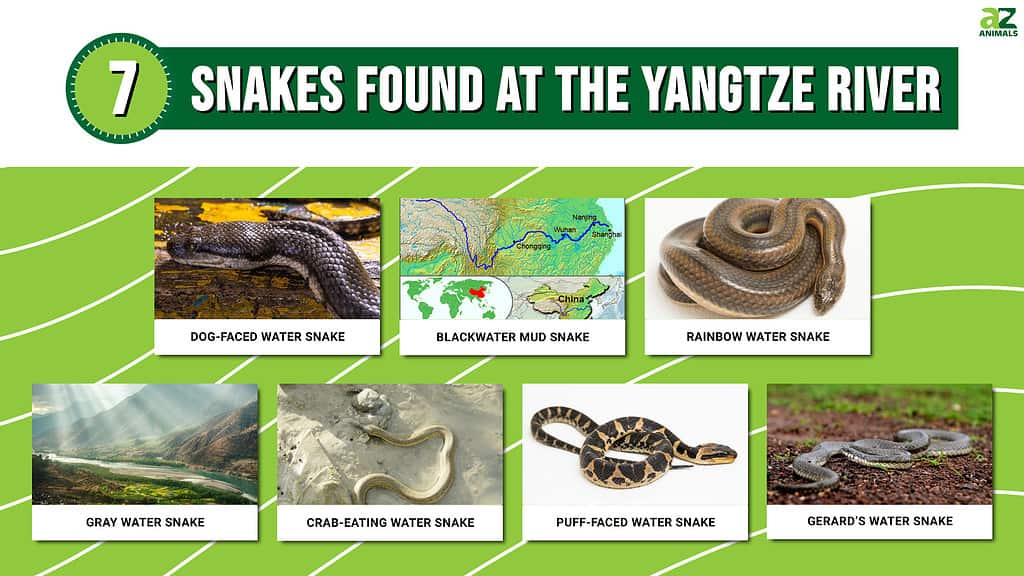
The Yangtze River is 3,975 miles, the longest in Asia and third in the world. Its source comes from the Jianggendiru Glacier in the Qinghai-Tibet Plateau of Central China, flowing eastward until it reaches the East China Sea. This river and its 700 tributaries have significantly influenced Chinese culture, dating back at least 7,000 years. The cities nestled along its water are populous and prosperous, providing vital resources.
Like all rivers, the Yangtze has immense wildlife, including reptiles like snakes. Most snakes on this list are aquatic or semiaquatic, meaning they can swim in water or slither on land near the river. Meet seven snakes found at the Yangtze River and learn more about their habitats.
1. Dog-Faced Water Snake

The dog-faced water snake lives in freshwater systems in Southeast Asia.
©iStock.com/ePhotocorp
Dog-faced water snakes are a shy species that use their coloration to blend with their environment. These brown and gray snakes inhabit mangroves in Southeast Asia, where they hide in thick mud and wait for the cover of darkness to feed on fish and invertebrates.
Dog-faced water snakes have several subspecies; some prefer coastal areas, while others live along freshwater river systems, like the Yangtze. They have particular adaptations that help them survive in their habitats, such as valve-like nostrils, salt-secreting glands, and the ability to sidewind across slippery mud. They also have eyes on top of their head to see above their muddy habitat.
2. Blackwater Mud Snake
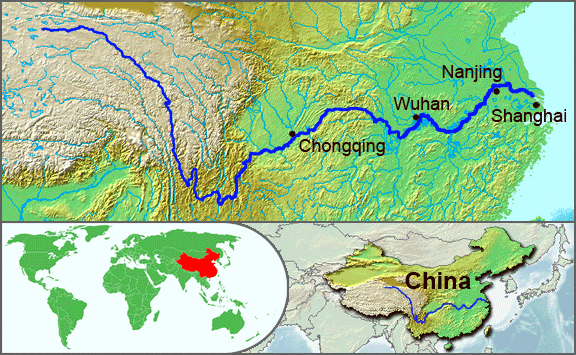
The blackwater mud snake is found along the Yangtze, the longest river in Asia, which flows across China.
©Papayoung / CC BY-SA 3.0 – License
The blackwater mud snake, Phytolopsis punctata, also known as the spotted water snake, is dark brown and gray with yellow bands and a bright yellow belly. Its head is the same size as its cylindrical body, with a short, tapered tail and eyes that sit on top of its head.
Unlike the dog-faced water snake, which is mildly venomous, the blackwater snake is non-venomous and not known for being aggressive. It, too, is a secretive snake, preferring to live in muddy flats near freshwater streams and rivers. Snakes are the favorite of this aquatic snake, where it waits for prey in the soft mud near forested shallow water.
3. Rainbow Water Snake
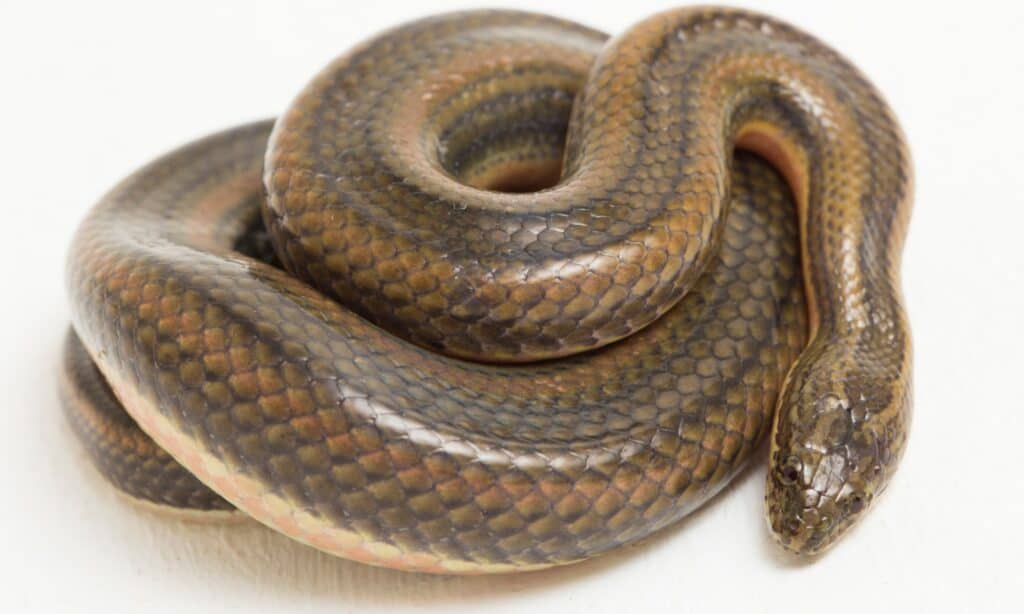
The rainbow water snake inhabits freshwater habitats in Southern China.
©iStock.com/dwi septiyana
The rainbow water snake is a colubrid species endemic to Asia, commonly found in the Southeast. It inhabits freshwater habitats near rural areas near marshlands and rice paddies. It is greenish-brown with two pale stripes that run down its body, converging at its crown.
Its flat head is narrower than its body, with a square snout, a short tail, and small eyes on its head. You may find this snake near the Yangtze region in Southern China. It is mildly venomous with rear fangs. However, it doesn’t use them on humans, opting for poking its tapered tails in defense.
4. Gray Water Snake

The gray water snake is often found in rice fields and irrigation canals in tropical South Asia.
©Depa Chandra S/Shutterstock.com
The gray water snake, also known as the rice snake, is one of the most common Asian water snakes, inhabiting slow-moving streams and other bodies of water in Southern China and other Southeastern Asia regions. It can be gray, dark brown, or olive on the upper side of its body and yellow on the underside with the occasional black spots. Its head is slightly wider than its cylindrical body, with a short tail and eyes on top of its head. Water snakes are often mistaken for dangerous water moccasins, but this species is non-venomous and is not considered a threat to humans.
5. Crab-Eating Water Snake
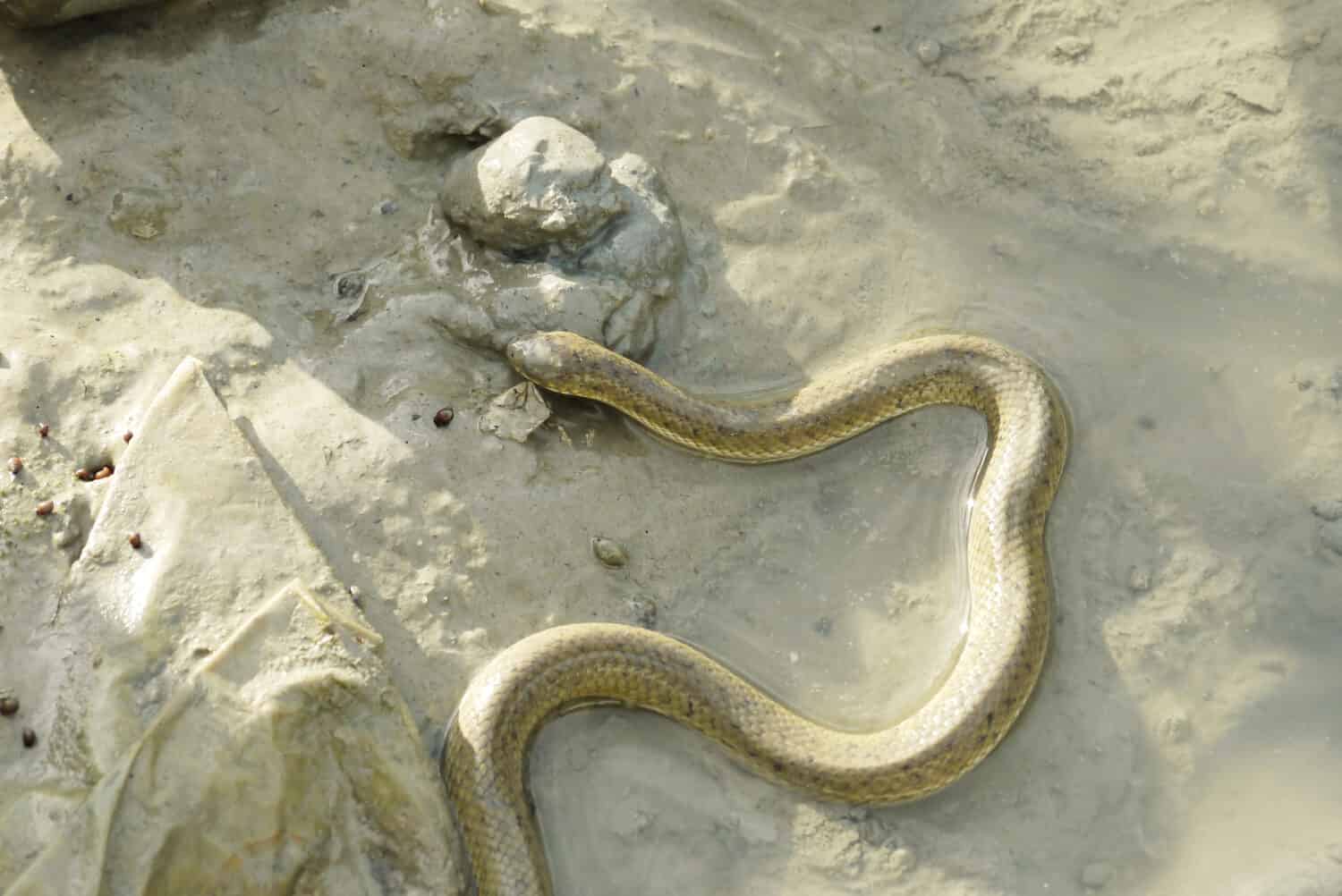
The crab-eating water snake confines itself mainly to tidal habitats and preys on small fish and crabs.
©Nicholas Toh/Shutterstock.com
The crab-eating water snake, also known as the white-bellied mangrove snake, slithers through Southeast Asia’s mangrove swamps and wetlands. This snake ranges from India and Thailand down to the Malay Peninsula and Indonesia. In some instances, you can find it in New Guinea and Northern Australia.
Like most water snakes, the snake has nostril valves, recessed jaws, and eyes on its head to help it thrive in its water habitats. It varies in color from brown to gray to purplish black with pale undersides. This snake feeds on small prey readily available in its environment, such as frogs, fish, and crabs (hence the name).
6. Puff-Faced Water Snake

The puff-faced water snake is endemic to tropical areas in Southeast Asia.
©dwi putra stock/Shutterstock.com
The puff-faced water snake, also known as the masked water snake, is a species belonging to the Homalopsidae family endemic to the tropical areas of Southeast Asia. It lives in freshwater systems like forest streams, ponds, and swamps, where it lives a nocturnal lifestyle.
Puff-faced snakes are brown and gray with distinctive banding (although less the older they get) with white bellies and keeled body scales. They have broad heads with recognizable markings, making them look “puffy.” They have a similar body build to the anaconda (reaching three feet in length), but they use a mild venom from their rear fang to take down their prey.
7. Gerard’s Water Snake
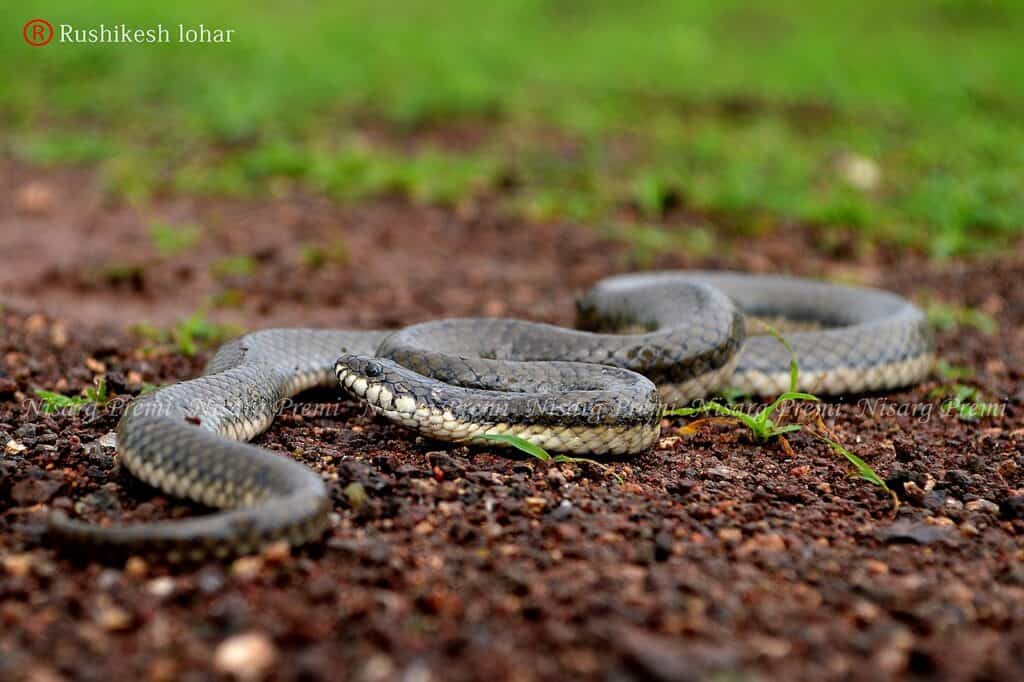
Gerard’s water snakes live in mangroves and feed on crabs and small fish.
©Rushikesh lohar / CC BY-SA 4.0 – License
Also known as the cat-eyed water snake, this species is from the Homalopsidae family endemic to Asia. The Gerard’s water snake mainly inhabits mangroves in the Southeast region, feeding on small fish and soft-shell crabs. Its coloration is either brown or gray, with its lower scales white or pale yellow. Like other water snakes, its head is barely distinct from its body, with its eyes atop its head.
What Other Animals Live Along the Yangtze River?
The Yangtze River basin is home to half of China’s plants and animals, including many on the brink of extinction. Here are some unique creatures you can find along this diverse river.
- Chinese alligator
- River dolphin
- Giant softshell turtle
- Giant salamander
- Chinese paddlefish
- Flying squirrel
- Chinese golden monkey
- Finless porpoise
- Giant panda
- Snow leopard
- Pangolin
Summary of 7 Snakes Found at the Yangtze River
| Name of Snake | Venomous or Not | Habitat | Diet |
|---|---|---|---|
| Dog-Faced Water Snake | Mildly venomous | Mangroves, where they hide in thick mud. | Fish and invertebrates. |
| Blackwater Mud Snake | Non-venomous | Muddy flats near freshwater streams and rivers. | Mainly fishes. |
| Rainbow Water Snake | Mildly venomous | Freshwater habitats near marshlands and rice paddies. | Fish, salamanders, tadpoles, earthworms, small frogs, and eels. |
| Gray Water Snake | Non-venomous | Slow moving waters, rice fields, and irrigation canals. | Fish, toads, and frogs. |
| Crab-Eating Water Snake | Non-venomous | Mangrove swamps and wetlands | Frogs, fish, and crabs |
| Puff-Faced Water Snake | Mildly venomous | Freshwater forest streams, ponds, and swamps. | Small fish or frogs. |
| Gerard’s Water Snake | Non-venomous | Mangroves | Small fish and soft-shell crabs |
The photo featured at the top of this post is © iStock.com/dwi septiyana
Discover the "Monster" Snake 5X Bigger than an Anaconda
Every day A-Z Animals sends out some of the most incredible facts in the world from our free newsletter. Want to discover the 10 most beautiful snakes in the world, a "snake island" where you're never more than 3 feet from danger, or a "monster" snake 5X larger than an anaconda? Then sign up right now and you'll start receiving our daily newsletter absolutely free.
Thank you for reading! Have some feedback for us? Contact the AZ Animals editorial team.






